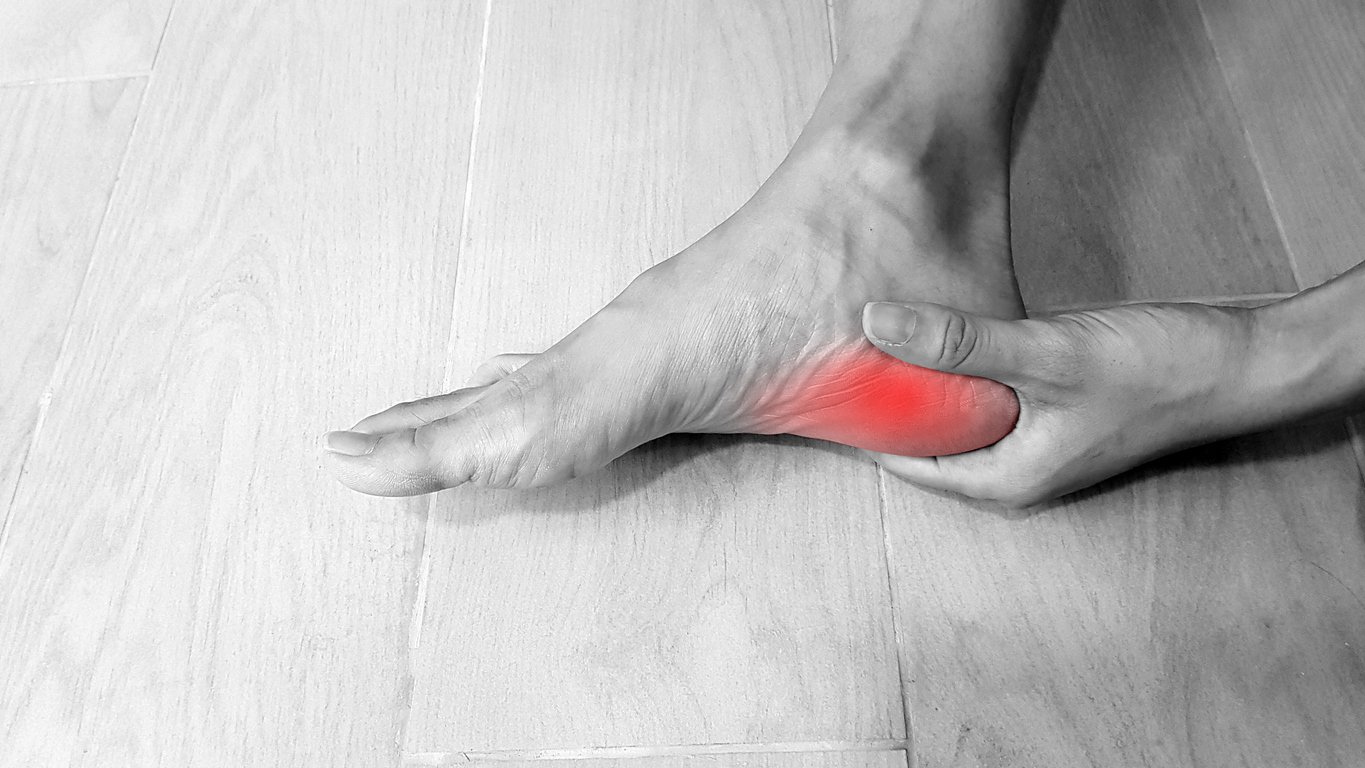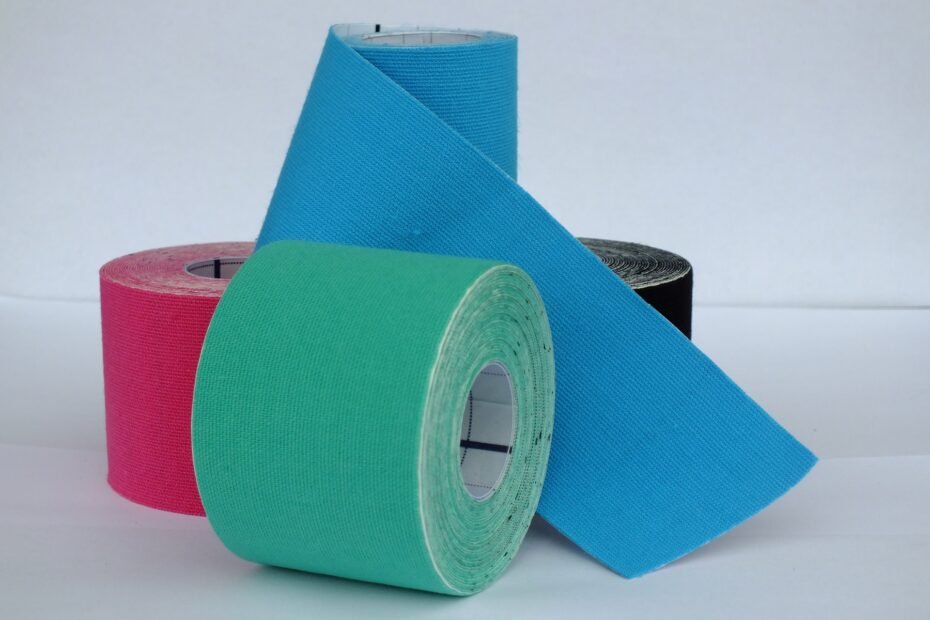Kinesio tape and plantar fasciitis, does it help? Lets examine this treatment option, but first what is plantar fasciitis?
Plantar Fasciitis is a common condition that can cause severe pain and discomfort in the foot. It occurs when the plantar fascia, a thick band of tissue that runs across the bottom of your foot, becomes inflamed. If you’re looking for an effective way to treat this condition, you’ve come to the right place. In this blog post, we’ll explore everything you need to know about Kinesiology Tape and how it can help alleviate the symptoms of Plantar Fasciitis.
We will discuss what Kinesiology Tape is, how it works, and why it is so effective in treating Plantar Fasciitis. We will also provide a step-by-step guide on how to apply Kinesiology Tape to get maximum relief from your pain. So, if you’re ready to say goodbye to Plantar Fasciitis once and for all, keep reading!
Understanding Plantar Fasciitis
Plantar fasciitis is a common foot condition that leads to heel pain. It arises from the inflammation of the plantar fascia, a thick band of tissue located in the foot.
Repetitive strain or overuse of the foot is often the cause of this condition, which accounts for approximately 10% of runner-related injuries. Interestingly, plantar fasciitis affects women twice as often as men. In fact, it causes plantar fasciitis pain in over 50 percent of Americans.
The foot pain associated with plantar fasciitis can significantly impact the quality of life for those affected. Understanding the causes and symptoms of this condition is essential in order to develop effective treatment methods.

Causes and Symptoms of Plantar Fasciitis
Causes and Symptoms of Plantar Fasciitis:
Plantar fasciitis is often caused by factors such as excessive physical activity, wearing improper footwear, or having foot structure problems. These common causes can lead to inflammation and pain in the plantar fascia, a thick band of tissue on the bottom of your foot.
One of the most prevalent symptoms of plantar fasciitis is heel pain, which is usually worse in the morning. Additionally, individuals with this condition may experience pain in the arch of the foot and the ball of the foot. Weight-bearing activities can worsen the discomfort.
By understanding the causes and recognizing the symptoms of plantar fasciitis, individuals can seek appropriate treatment methods to alleviate foot pain and improve the quality of life. Conservative treatments such as kinesiology taping, extracorporeal shockwave therapy, and shoe inserts have shown positive results in reducing pain levels and improving stability for patients. Following these treatments, it is important to monitor the stability of patients using control groups and study designs that consider exclusion criteria.
Plantar fascia taping, utilizing various techniques such as zinc oxide tape strips or the application of kinesiology tape, has been found to be beneficial in managing plantar fasciitis. The tape is applied to the bottom of the foot, along the arch, and around the back of the heel, providing support for the arch and helping to alleviate pain. This plantar fasciitis taping technique can be combined with other treatments like stretching exercises and physical therapy for optimal results. However, it is necessary to consult a healthcare professional, such as a physical therapist experienced in taping techniques, to ensure proper application and long-term relief.
What is Kinesiology Tape?
Kinesiology tape is a flexible and breathable athletic tape used for pain relief and support in physical therapy and sports medicine. It mimics the elasticity of the skin and muscles, making it effective for conditions like plantar fasciitis.
The Science Behind Kinesiology Tape
Kinesiology tape, also known as kinesio tape, is a widely used tool in the treatment of various musculoskeletal conditions, including plantar fasciitis. This innovative tape, designed by KT Health, works by providing support and stability to the muscles and joints while allowing for a full range of motion. Its adhesive quality and tension on the skin and muscles help reduce pain and inflammation associated with foot problems like plantar fasciitis.
But how does kinesiology tape achieve these impressive results? The tape’s unique design consists of three distinct parts: medial, central, and lateral bands. These bands work together to create a supportive structure that mimics the natural movement of your foot, including support for the medial arch. By applying the tape in strategic patterns, it helps improve blood flow and lymphatic circulation in the taped area, which can aid in the healing process.
Scientific studies have shown that kinesiology tape can have positive effects on patients with plantar fasciitis. Researchers have observed improvements in pain levels, stability, and quality of life in those who used kinesiology taping techniques compared to a control group. This evidence supports the use of kinesio tape as a valuable adjunct to conservative treatments for plantar fasciitis.
In summary, kinesiology tape offers a scientifically backed approach to managing plantar fasciitis. Its unique design and adhesive properties provide support, reduce pain and inflammation, and promote healing in the foot. Incorporating kinesiology tape into your treatment plan, along with other recommended therapies, may help you find relief from the discomfort caused by plantar fasciitis.
How Does Kinesiology Tape Aid in Treating Plantar Fasciitis?
Kinesiology tape can aid in treating plantar fasciitis by providing pain relief and support to the foot and arch. It helps reduce strain on the plantar fascia, allowing for faster healing and pain relief. The tape also improves foot and ankle stability, preventing further discomfort.
Implementing Kinesiology Tape for Plantar Fasciitis Relief
When it comes to implementing kinesiology tape for plantar fasciitis relief, there are a few necessary materials you’ll need. These include kinesiology tape, scissors, and a clean and dry foot. To apply the tape effectively, start by cleaning and drying your foot, and position it in a neutral position.
Once you have prepared your foot, follow a step-by-step guide for taping. It’s crucial to ensure proper tension and placement of the tape for maximum effectiveness. By doing so, you can provide support and stability to the foot, reducing strain on the plantar fascia and promoting healing.
Implementing kinesiology tape for plantar fasciitis relief offers a conservative treatment option that can significantly improve your quality of life. Numerous studies have demonstrated positive results when using kinesiology taping techniques for conditions like this. The tape provides support while allowing for a full range of motion, aiding in pain reduction, and inflammation control.
By following the appropriate taping techniques, you can experience relief from foot pain associated with plantar fasciitis and enjoy long-term benefits.

Necessary Materials for Taping
When it comes to kinesio tape and plantar fasciitis, having the necessary materials for taping is crucial. To effectively tape your foot and provide relief from foot pain, you will need a few key items. First and foremost, look for high-quality kinesio tape that is specifically designed for sports and athletic activities. This type of tape is stretchy and provides the support your foot needs during movement.
In addition to kinesio tape, sharp and clean scissors are essential for cutting the tape to your desired length and shape. Pre-wrap is another important material to have on hand. Applying a thin layer of pre-wrap to the skin before taping can help prevent irritation and discomfort. To enhance the adhesion of the tape and prevent it from peeling or slipping, consider using a skin-friendly adhesive spray.
Lastly, don’t forget alcohol wipes to cleanse the skin thoroughly before applying the tape. This step ensures better adhesion and helps prevent infection. By gathering and using these necessary materials, you can effectively apply kinesio tape for plantar fasciitis and experience the benefits of this conservative treatment method.
Step-by-Step Guide to Apply Kinesiology Tape
When using kinesiology tape for plantar fasciitis, it’s important to follow a step-by-step guide to ensure proper application and maximum effectiveness. Start by cleaning the area thoroughly to remove any dirt or oils that could interfere with the tape’s adhesion. Next, measure and cut the desired length of tape, making sure to round the edges to prevent peeling. Apply the tape with a slight stretch, taking care to avoid wrinkles or creases that could cause discomfort. Gently rub the tape to activate the adhesive and ensure it sticks properly to your foot. If needed, you can use a hair dryer to further activate the adhesive. By following these steps, you can effectively apply kinesiology tape for plantar fasciitis relief.
Need a visual guide? Click here https://youtu.be/8jk4Yz4P0AU?si=kujAx41qbgueVj7A
Can Kinesiology Tape Provide Long-Term Relief for Plantar Fasciitis?
Limited research exists on the long-term effectiveness of kinesiology tape for plantar fasciitis. While it can offer short-term relief from pain, consult with a healthcare professional before using it for long-term relief. Proper application can support the arch and reduce strain on the plantar fascia.

Frequently Asked Questions
Can Kinesio Tape be used in conjunction with other treatments for plantar fasciitis?
Kinesio Tape can complement other treatments for plantar fasciitis. Consulting a healthcare professional is important before using it. Other treatments may include stretching exercises, physical therapy, and pain medication. Kinesio Tape provides support and pain relief but should not be the sole treatment option.
How long should I wear Kinesio Tape for plantar fasciitis and how often should I replace it?
Kinesio Tape can be worn for up to five days at a time to treat plantar fasciitis. It is recommended to replace the tape every three to four days for optimal effectiveness. Make sure your skin is clean and dry before applying the tape, and remove it immediately if you experience any discomfort or irritation.
Are there any risks or side effects associated with using Kinesio Tape for plantar fasciitis?
Using Kinesio Tape for plantar fasciitis may have some risks or side effects. These include possible skin irritation or allergic reactions. It’s crucial to apply the tape correctly and seek professional advice, especially if you have underlying medical conditions or take medications. If you experience discomfort or adverse reactions, remove the tape immediately.
Conclusion
In conclusion, Kinesiology Tape can be a valuable tool in the treatment of Plantar Fasciitis. Its ability to provide support, reduce pain and inflammation, and improve blood flow makes it an effective option for managing symptoms. However, it is important to remember that Kinesiology Tape is not a cure-all solution and should be used in conjunction with other treatment methods. It is always best to consult with a healthcare professional before trying any new treatment approach. With the proper application and adherence to a comprehensive treatment plan, Kinesiology Tape can provide long-term relief and help individuals with Plantar Fasciitis get back to their active lifestyles.
I hope you found this blog helpful and please feel free to comment and/ or share.
Check out a couple of my other blogs here:
https://theheelgp.com/what-is-the-cure-for-plantar-fasciitis-the-heel-gp-com /
https://theheelgp.com/foot-massage-plantar-fasciitis-the-heel-gp-com/
 | Tracy J. Founder, The heel GP |

Insightful guide! kinesio tape impact on plantar fasciitis is often underestimated. Great breakdown of its benefits and application. Appreciate the detailed info!
Thanks for your kind comment Brian.